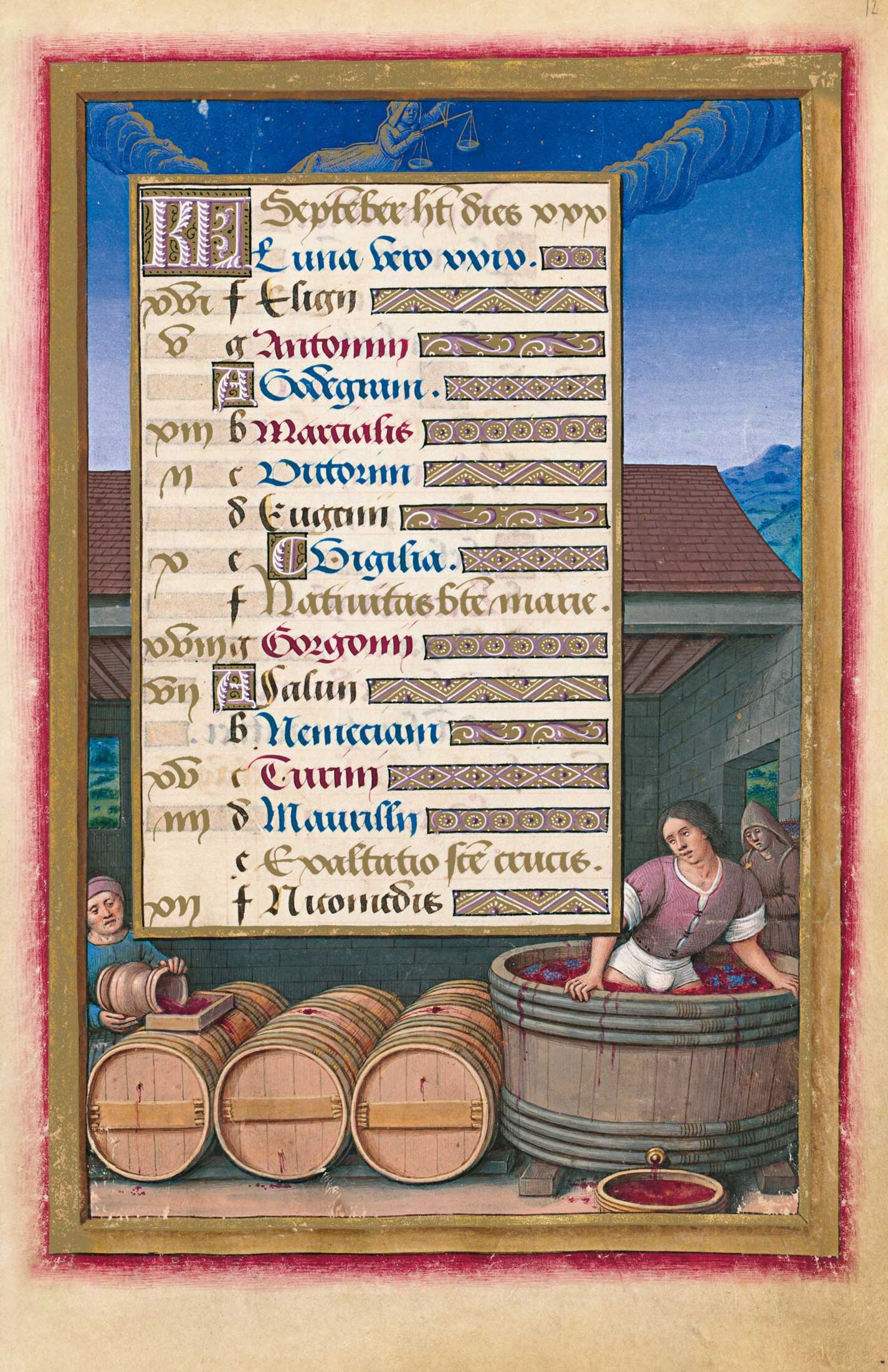The constellation of Libra appears in the form of a postrate woman wearing a headdress and gown holding a very detailed, unbalanced pair of scales. In the earthly section the grape harvest activities being carried out in the cella vinaria or wine celler because of the climate, occupy the entire scene. The man on the left uses a quadrangular, wooden funnel to fill a wine barrel. Next to him, is a peasant, dressed down to his thighs – in surprisingly clean clothes, within the idealist iconography of the Great Hours – possibly doing the second round of grape trampling. He is inside a cylindrical wine press which is slightly wider at the top mounted on two wooden supports. Floating inside are black grapes and the contents spill over the rim and, particularly, along a projecting, metal channel at the bottom through which the grape juice flows into a keg. Finally, another man in contemporary dress, carries a qualus, a hamper or deep basket full of recently-picked, black grapes to be thrown into the grape press, for trampling starts at the same time as the grape harvest. The advantage of this task is that neither the seeds nor the stalk are squeezed, thereby avoiding increasing the acidity of the wine, which would spoil its flavour. The landscape glimpsed behind the grape press is calm in comparison with previous scenes.
Like the grape harvest, trampling is almost always set in September. Since Antiquity, these images have had a considerable, iconographic tradition, originally as separate scenes and subsequently together during the Gothic centuries. Hence, the earliest representations of two or more people busy at vine-growing tasks originated in Late Roman times. Trampling grapes in a grape press or calcatorium was often found in ancient images of the months and seasons and persisted in both painting and sculpture in France and Italy. Besides this contribution made by ancient art, it must also be said that Carolingian illustrations became more developed and lavish with the onset in Gothic times of decorative and landscape details, until they came to coexist alongside other scenes typical of the month. The barrel-filling or wine-decanting scene appears in Carolingian miniatures by the school of Salzburg, and became extremely popular in twelfth-and thirteenth-century monumental cycles, following which it appeared in just the occasional painted calendar in the 14th and 15th centuries. Barrels, in the sense of individual objects related to peasant work, were already to be found in Roman steles. They were subsequently incorporated into Roman images, which were enhanced with more or less anecdotic motifs, and finally added to the farming calendar repertory in the Gothic period. Like hay-making, grape harvesting tasks were depicted in most northern menologies since, along with cereal-based products, wine was another mainstay of the peasant diet.

The constellation of Libra appears in the form of a postrate woman wearing a headdress and gown holding a very detailed, unbalanced pair of scales. In the earthly section the grape harvest activities being carried out in the cella vinaria or wine celler because of the climate, occupy the entire scene. The man on the left uses a quadrangular, wooden funnel to fill a wine barrel. Next to him, is a peasant, dressed down to his thighs – in surprisingly clean clothes, within the idealist iconography of the Great Hours – possibly doing the second round of grape trampling. He is inside a cylindrical wine press which is slightly wider at the top mounted on two wooden supports. Floating inside are black grapes and the contents spill over the rim and, particularly, along a projecting, metal channel at the bottom through which the grape juice flows into a keg. Finally, another man in contemporary dress, carries a qualus, a hamper or deep basket full of recently-picked, black grapes to be thrown into the grape press, for trampling starts at the same time as the grape harvest. The advantage of this task is that neither the seeds nor the stalk are squeezed, thereby avoiding increasing the acidity of the wine, which would spoil its flavour. The landscape glimpsed behind the grape press is calm in comparison with previous scenes.
Like the grape harvest, trampling is almost always set in September. Since Antiquity, these images have had a considerable, iconographic tradition, originally as separate scenes and subsequently together during the Gothic centuries. Hence, the earliest representations of two or more people busy at vine-growing tasks originated in Late Roman times. Trampling grapes in a grape press or calcatorium was often found in ancient images of the months and seasons and persisted in both painting and sculpture in France and Italy. Besides this contribution made by ancient art, it must also be said that Carolingian illustrations became more developed and lavish with the onset in Gothic times of decorative and landscape details, until they came to coexist alongside other scenes typical of the month. The barrel-filling or wine-decanting scene appears in Carolingian miniatures by the school of Salzburg, and became extremely popular in twelfth-and thirteenth-century monumental cycles, following which it appeared in just the occasional painted calendar in the 14th and 15th centuries. Barrels, in the sense of individual objects related to peasant work, were already to be found in Roman steles. They were subsequently incorporated into Roman images, which were enhanced with more or less anecdotic motifs, and finally added to the farming calendar repertory in the Gothic period. Like hay-making, grape harvesting tasks were depicted in most northern menologies since, along with cereal-based products, wine was another mainstay of the peasant diet.